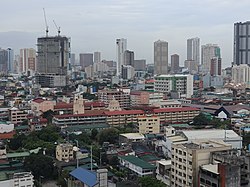
Antipolo, officially the City of Antipolo, is a 1st class component city and capital of the province of Rizal, Philippines. According to the 2020 census, it has a population of 887,399 people. It is the most populous city in the Calabarzon region, and the seventh most-populous city in the Philippines. It is also the most populated city under the component city status.

Quiapo is a district of the city of Manila, in the National Capital Region of the Philippines. Referred to as the “Old Downtown of Manila", the district’s most famous landmark is Quiapo Church, a minor basilica enshrining the Black Nazarene image processed every January by millions of devotees. Quiapo is also known as a place for bargain hunting.
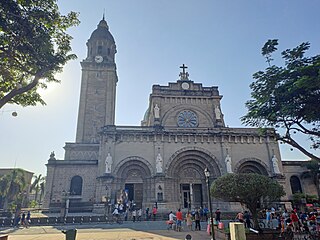
The Archdiocese of Manila is the archdiocese of the Latin Church of the Catholic Church in Metro Manila, Philippines, encompassing the cities of Manila, Makati, San Juan, Mandaluyong, Pasay, and Taguig. Its cathedral is the Minor Basilica and Metropolitan Cathedral of the Immaculate Conception, also known as the Manila Cathedral, located in Intramuros, which comprises the old city of Manila. The Blessed Virgin Mary, under the title Immaculate Conception, is the principal patroness of the archdiocese.

Malate is a district of Manila, Philippines. Together with the district of Ermita, it serves as Manila's center for commerce and tourism.
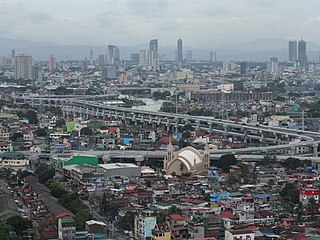
Pandacan is a district in Manila, Philippines which is known in recent history for its former Pandacan oil depot which supplies the majority of oil exports in the country.
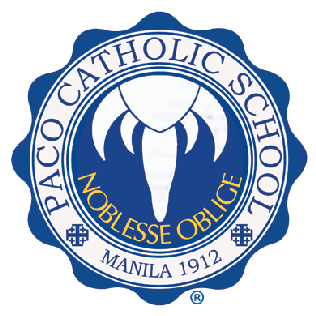
Paco Catholic School is a co-institutional private school located in the district of Paco in the City of Manila, Philippines. Paco Catholic school started in November, 1912 as an informal class for 50 young boys inside the chapel in the Peñafrancia section of the district by Raymond Esquinet, CICM, who was succeeded by Fr. Godofredo Aldenhuijsen, CICM. On May 14, 2022, in the 325th anniversary of the arrival of the Peñafrancia image in Manila and the 70th anniversary of the Parish, Jose Advincula solemnly declared the Paco Chapel, the same site of PCS, now Parish Church, the Archdiocesan Shrine of Our Lady of Peñafrancia.

Nihonmachi is a term used to refer to historical Japanese communities in Southeast and East Asia. The term has come to also be applied to several modern-day communities, though most of these are called simply "Japantown", in imitation of the common term "Chinatown".

Paco station is a railway station located on the South Main Line in the city of Manila, Philippines. It was originally opened by the Manila Railroad Company in 1908 as a major hub in the southern half of Manila, where trains toward Cavite province once operated. The old train station building was designed by William E. Parsons and was completed in 1915. Prior to the electrification plan in the late 1970s, Paco was the southernmost double-track station on the line.
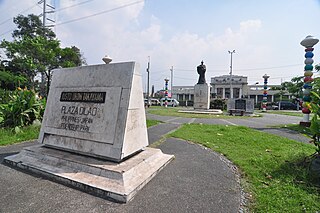
Plaza Dilao is a public square in Paco, Manila, bounded by Quirino Avenue to the east, and the rest of the plaza surrounded by the Plaza Dilao Road and Quirino Avenue Extension. The former site of a Spanish colonial era Japanese settlement, it prominently features a memorial commemorating Japanese Roman Catholic kirishitan daimyō Dom Justo Takayama, who settled there in 1615. It is one of two open public spaces in Paco, the other being Paco Park.

Circumferential Road 2 (C-2), informally known as the C-2 Road, is a network of roads and bridges that all together form the second beltway of Metro Manila in the Philippines. Spanning some 10.18 kilometers (6.33 mi), it connects the districts of Tondo, Santa Cruz, Sampaloc, San Miguel, Santa Mesa, Paco, Pandacan, and Malate in Manila.

In Metro Manila, Philippines, tourism is a significant industry. In 2012, the city and the region welcomed 974,379 overnight visitors. Serving as the main gateway to the Philippines' numerous destinations, the city attracts mainly international tourists, with a total of 3,139,756 visitors in 2012. Global Blue ranks Manila as the eleventh 'Best Shopping Destination' in Asia. The city holds the tenth position in MasterCard's global top 20 fastest-growing cities for international visitors from 2009 to 2013.

The San Fernando de Dilao Parish, also known as Paco Church, is a parish church located in the district of Paco in the city of Manila, Philippines, honoring the Castillian king Saint Ferdinand III of Castile. From February 7, 2012 to April 9, 2014, the parish was used as the pro-cathedral of Manila, during the structural renovations of the Manila Cathedral. The church inside is notable for its Romanesque-Byzantine interior with recently Italian Baroque styled altar, most notably the Latin inscriptions similar in style to Saint Peter's Basilica in Rome.

United Nations Avenue is a major thoroughfare in Manila, Philippines. A commercial, residential and industrial artery, the avenue runs east–west through the near-center of the city linking Ermita and Rizal Park with the eastern districts. It is home to the World Health Organization Western Pacific headquarters.

Pedro Gil Street is an east-west inner city street and a tertiary national road in south-central Manila, Philippines. It is 3.65 kilometers (2.27 mi) long and spans the entire length of Ermita, Malate, Paco, and Santa Ana. The street is served by the Pedro Gil LRT Station along Taft Avenue and the Paco railway station along Quirino Avenue. It also continues towards the central Metro Manila cities of Mandaluyong and San Juan across the Pasig River as New Panaderos and General Kalentong Streets.

President Elpidio Quirino Avenue, more commonly known as Quirino Avenue, is a 6-10 lane divided highway in Manila, Philippines. It runs for 3.6 kilometers (2.2 mi) in a northeast–southwest direction from Nagtahan Bridge across from Santa Mesa in the north to Roxas Boulevard in Malate in the south. It passes through Paco and Pandacan districts where it also serves as a truck route between Port Area and South Luzon Expressway. North of Nagtahan Bridge, the road continues as Nagtahan Street. It is designated as part of Circumferential Road 2. It is named after Elpidio Quirino, the sixth President of the Philippines.
The following is a timeline of the history of the city and metropolitan area of Manila, the capital city of the Philippines.

The Royal Parish and National Shrine of Saint Michael and the Archangels, also known as San Miguel Church, is a Roman Catholic church of the Latin Church dedicated to the archangels, namely, Saint Michael, Saint Gabriel, Saint Raphael.

The following outline is provided as an overview of and topical guide to Metro Manila:

The following is an alphabetical list of articles related to the Philippine capital region of Metro Manila.

La Huerta is a barangay in the city of Parañaque, Metro Manila, Philippines. It comprises a section of the old poblacion of Parañaque along the south bank of the Parañaque River by its mouth in Manila Bay. The coastal village encompasses the area from Don Galo on the north, Santo Niño and Moonwalk on the east and San Dionisio on the south. A portion of Global Airport Business Park along C-5 Road Extension is also under the jurisdiction of La Huerta. It also extends west to the reclaimed area in Manila Bay and covers the northernmost section of Freedom Island in the Las Piñas–Parañaque Critical Habitat and Ecotourism Area. As of the 2020 census, it had a population of 8,592.
